
No plant satisfies the craving for a taste of the tropics like alocasias, popular in Victorian times, they have enjoyed a rebirth in the recent craze for zonal-denial, exotic plants. The most recognized forms have oversized leaves, inspiring the common name elephant ears.
Swipe to view slides
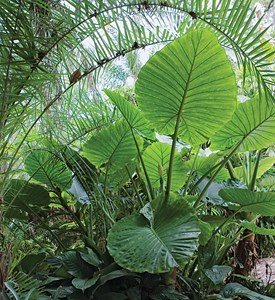
Photo by: Chelsea Stickel.
1. ALOCASIA ‘CALIDORA’
Big, dramatic hybrid of A. gagaena and A. odora, reaching five to seven feet tall with rounded, sky-pointing, dark green leaves nearly four feet long and three feet wide. Forms a “trunk” and thick sturdy stalks. Easy and fast in a partly sunny location.
Hardy in Zones 9 to 11.
A. MACRORRHIZA ‘BLACKSTEM’ – Photo by: Pam Mclean.”><img alt="A. MACRORRHIZA ‘BLACKSTEM’ – Photo by: Pam Mclean.” data-companylocation=”Calimesa, CA” data-companyname=”Garden Design” height=”300″ itemprop=”url” src=”http://www.gardendesign.com/pictures/images/275x300Exact/site_3/large-elephant-ear-alocasia-macrorrhiza-blackstem-garden-design_11015.jpg” width=”275″>
Photo by: Pam Mclean.
2. A. MACRORRHIZA ‘BLACKSTEM’
A large elephant ear, three to five feet tall, with upward-pointing, two-foot wide, dark green leaves, slightly ruffled along the edges. Leaf stalks and veins on the leaf undersides are a striking ebony purple. Prefers part sun to shade.
Hardy in Zones 9 to 11.
A. LAUTERBACHIANA – Photo by: Pam Mclean.”><img alt="A. LAUTERBACHIANA – Photo by: Pam Mclean.” data-companylocation=”Calimesa, CA” data-companyname=”Garden Design” height=”300″ itemprop=”url” src=”http://www.gardendesign.com/pictures/images/275x300Exact/site_3/elephant-ear-alocasia-lauterbachiana-garden-design_11014.jpg” width=”275″>
Photo by: Rob Cardillo.
3. A. LAUTERBACHIANA
A native of New Guinea previously included in the genus xenophya. Long, narrow, swordlike leaves, green with a bluish cast on top, mauve-purple beneath, and scalloped on the edges, are unusual for an alocasia and make a dramatic vertical statement. Can reach five feet in height.
Hardy in Zones 9 to 11, maybe Zone 8 with extra winter protection.
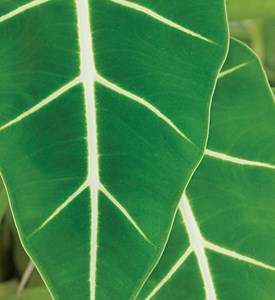
Photo by: Pam Mclean.
4. A. MICHOLITZIANA ‘FRYDEK’
Velvety emerald-green leaves with prominent white veins are eight to 12 inches long and arrowhead shaped. Grows two to three feet tall in the shade garden or a container. Attractive purple-banded leaf stalks add extra interest.
Hardy in Zones 9 to 11; also makes an easy houseplant.
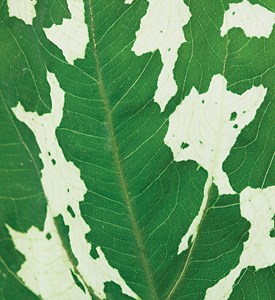
Photo by: Pam Mclean.
5. A. ‘HILO BEAUTY’
Striking elephant ear with a mosaic pattern of green, cream and yellow on its foliage. Plant usually stays under three feet tall, with leaves one foot long and six inches wide. A robust grower for a garden with shade or filtered light. Can also be grown in a terrarium while a young plant then moved outdoors or into a container.
Root-hardy as far north as Zone 8; goes dormant at 45 degrees.
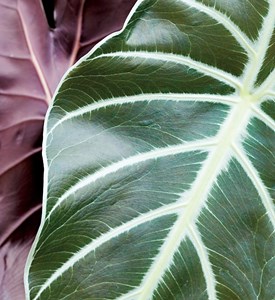
Photo by: Pam Mclean.
6. A. ‘PURPLE PRINCE’
A hybrid elephant ear with waxy, arrowhead-shaped, purplish green leaves with iridescent veining and eggplant colored undersides, one to two feet long. Can reach three to four feet. Prefers shade or bright diffused light.
Hardy in Zones 9 to 11.
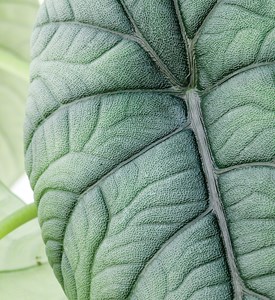
Photo by: Pam Mclean.
7. A. RUGOSA
Even when you touch this elephant ear, it’s hard to believe it’s real. Thick, quilted leaves with nubby texture feel like plastic. A smaller alocasia, typically eight to 12 inches tall.
Hardy to Zone 9 outdoors but makes an easy houseplant (or terrarium specimen) since it is slow-growing and can take the low light and dry air typical of indoor situations.
Growing Elephant Ears
Their rapid growth creates a show even during a short growing season, making them worthy as one-shot annuals of benefit to northern gardeners. But among the 70 or so species and their cultivars are alocasias small, medium and large, in leaf shapes from wide hearts to slim arrowheads, with colorful veining and textures from slick and glossy to thick and waxy. While their use in gardens has given them their current cachet, many also make good houseplants.
Appeal:
High drama and bold texture are the signature benefits of showcasing alocasias in a garden or container.
Zones:
Though most alocasias are native to the humid tropical climates of Southeast Asia and are fully hardy in Zones 9 to 11, many are proving root-hardy in Zone 8 and a very few in Zone 7. Most can endure temperatures down to 30 degrees, but will go dormant with a frost or temperatures below 45. In zones colder than 8, or with less hardy alocasias, the tuberous rhizomes can be stored over winter. After a frost, cut back foliage and dig up rhizomes. Allow to dry for a few days, then store in an open container with peat moss or dry potting soil barely covering the rhizome, in a cool (45 to 55 degrees), dry place. For winter protection outdoors in Zone 8 (and Zone 7 if you’re feeling lucky), cover the base of the plant with four to 12 inches of mulch.
Exposure:
Most alocasias prefer filtered sun or shade, but some tolerate full sun. In general, green types can take higher light levels; dark-leaved ones need shade.
Soil:
Alocasias need rich soil that is moist (not saturated) but well-drained. No elephant ear likes wet feet (the big-leaved plants you see in water gardens are the close cousins colocasias, also sometimes called elephant ears), though a few are tolerant of wet conditions. A general rule is big, green alocasias are practically indestructible and can tolerate variable moisture conditions; dark-leaved types will suffer if over watered and can stay dry for several days. Alocasias are not heavy feeders. Apply a slow-release fertilizer at planting time; in a pot, a tablespoon per six-inch pot is plenty; use incrementally more for larger containers.
Care:
If foliage shows yellowing, it’s probably a micronutrient deficiency. A fertilizer with micronutrients can be applied, or sprinkle Epsom salts around the base of each plant on a monthly basis. To prevent disease problems, water alocasias in the morning so they go into the night dry. If possible, water from below at the root zone rather than from above, to keep water off the leaves.
Designing with Alocasias
- Add oversized elephant ears to the perennial border for a dramatic focal point. A plant with large green leaves also gives the eye a rest amidst masses of colorful flowers.
- Alocasias make good companions and dramatic centerpieces in mixed containers, used with other foliage plants and flowering annuals that like filtered sunlight and moist soil. Use one of the larger types in a big pot for a showstopper.
- Purple-foliaged species combine well with silver, pink and chartreuse plants.
- Combine elephant ears with other tropical-looking plants like cannas, bananas, variegated tapioca, caladiums and coleus for a summer jungle garden.
- An alocasia in a container placed out in the garden can be a movable focal point, and can hide the bare spot left when spring-blooming bulbs go dormant.
RELATED:
Tropical Gardens
Bromeliads
Hostas